It's 5 a.m. and a cool breeze chills the air. Lights burst on in market sheds and trucks rumble in as farmers from Michigan, Ohio and just across the river in Canada hurry to unload their produce and other goods before the crowds begin to arrive at 6 a.m. Soon, colorful mounds of tomatoes, corn and spices are piled high, heaps of flowers spill over the pavement, and fresh eggs, meat, cheese and handmade baked goods tempt shoppers to fill their tote bags.
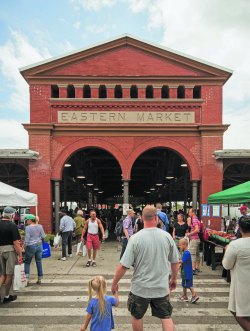 Today, like every Saturday, as many as 45,000 visitors will come together in Detroit’s famous Eastern Market. They arrive from the inner city and from the suburbs and hail from different countries, races, religions, ages and income brackets. The smooth tones of a tenor sax accompany the cacophony of laughter, conversation in several languages and vendors shouting out the prices of their goods. The entire market vibrates with vitality and a strong sense of community—embodying history, altruism, civility, tolerance and work ethic—which contributes to a life well lived for its players.
Today, like every Saturday, as many as 45,000 visitors will come together in Detroit’s famous Eastern Market. They arrive from the inner city and from the suburbs and hail from different countries, races, religions, ages and income brackets. The smooth tones of a tenor sax accompany the cacophony of laughter, conversation in several languages and vendors shouting out the prices of their goods. The entire market vibrates with vitality and a strong sense of community—embodying history, altruism, civility, tolerance and work ethic—which contributes to a life well lived for its players.
Detroit probably isn’t the first place that comes to mind when you think of such bounty and harmony. Yet, here in the country’s largest open-air public market, people as diverse as the produce have converged for 125 years.
Meet me at the market
“There are very few places now where a variety of people come together naturally,” says Heather Dillaway, Ph.D., associate professor of sociology at Wayne State University in Detroit. “Eastern Market is the exception.” Heather, who is an Eastern Market shopper, says, “When people have a common reason to be in a space together, they can create conversation and talk across boundaries. While they’re there, they realize they have more commonalities that bridge differences.”
In the case of the Eastern Market, “You've got hipsters buying okra, broccolini and handmade sausage, but others are there for affordable food, loading up provisions for their restaurant or they’re there to support food justice [idea that access to healthy food is a basic human right] and to shop in ways to reduce their carbon footprint. There’s a common purpose.
“This is how things have happened through history,” Heather says. “People have come together over a common issue such as public health or the right to vote, for example.” Suddenly, disparate groups discover they have something in common and start talking to each other. “Food is one of those needs that puts people on equal footing.”
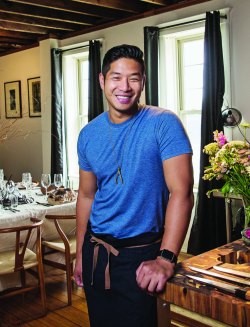 Detroit chef and budding restaurateur Jon Kung’s experiences with his business Kung Food back that up. “Having a personal relationship with your merchant is amazing,” Jon says. “It is truly a gift to have people there to guide me through product changes or conditions. It can even be something as simple as ‘we had a lot of rain yesterday so these tomatoes are pretty much ready to burst, be extra careful bringing them home.’ Sometimes I even tell farmers what ingredients I’ll be looking for and they may take it upon themselves to grow it.” And for the merchants, such exchanges help them establish loyal customers.
Detroit chef and budding restaurateur Jon Kung’s experiences with his business Kung Food back that up. “Having a personal relationship with your merchant is amazing,” Jon says. “It is truly a gift to have people there to guide me through product changes or conditions. It can even be something as simple as ‘we had a lot of rain yesterday so these tomatoes are pretty much ready to burst, be extra careful bringing them home.’ Sometimes I even tell farmers what ingredients I’ll be looking for and they may take it upon themselves to grow it.” And for the merchants, such exchanges help them establish loyal customers.
“Life is what you make of it, and that includes how much you truly want to interact with someone,” Jon says. “The market is a place where you can do that. We’re aware of each other constantly, and we understand the community we’re in. The market is a food-based microcosm of all that’s good in the city.”
Strong roots
Detroit has had its challenges, among them urban blight and right, job losses and government corruption. But Motown is getting its groove back with enough construction projects, business startups, new residents and sports facilities in the works to make many cities envious. Guess what destination made Travel and Leisure’s list of “places to go in 2016.” Yep, Detroit.
While the newcomers generate excitement, Eastern Market bears the special patina of time. It has bloomed here despite Detroit’s ups and downs and proudly remains one place where native Detroiters can say, “We’re still here. We've been here all along.”
In fact, the market in some form has been entwined with this city’s history practically since the first settlers pulled their canoes up on the banks of the Detroit River. It moved to its current location in 1891 and German, Italian and Polish neighborhoods grew up around it. To this day, Eastern Market revolves around a core of five massive sheds where hundreds of wholesale and retail vendors sell fresh produce, meat and much more daily.
Family roots
This is no simple farmers market; it’s a working food district, with acres of shops and housing that have sprouted up around the central sheds over the decades. Some families have earned a living at Eastern Market for generations. Larry Konowalski’s family has sold eggs here for more than 100 years and, at age 75, he continues the tradition, arriving at the market with eggs and honey from his farm in nearby Adrian, Michigan.
“I simply enjoy being at the market,” Larry says. “I’ve been going all my life and now I have customers whose grandparents dealt with my grandparents, who came by horse and wagon on Friday nights to be ready when the market opened early the next morning.” Such continuity is remarkable. So are the personal relationships people used to develop more readily in their communities, partly through their interaction with those who supplied their food. That’s a relationship both Larry and his customers value today. He says he knows more people at the market than he does in Adrian.
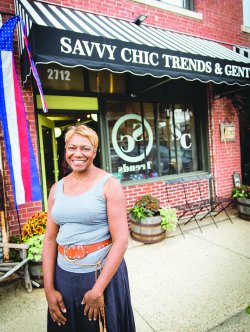 Markets like Detroit’s once thrived in cities throughout America. After World War II, though, city dwellers moved to the suburbs and bought groceries in big new supermarkets. It’s no small irony that the auto industry that made Detroit famous built the cars that drove people out of the city. And they took many of the jobs with them. The Motor City, once so admired as the “arsenal of democracy,” the nation's fourth largest city, and a prime place to attain the American Dream eventually became scorned for its poverty and its eerie landscape of empty lots and burned-out houses.
Markets like Detroit’s once thrived in cities throughout America. After World War II, though, city dwellers moved to the suburbs and bought groceries in big new supermarkets. It’s no small irony that the auto industry that made Detroit famous built the cars that drove people out of the city. And they took many of the jobs with them. The Motor City, once so admired as the “arsenal of democracy,” the nation's fourth largest city, and a prime place to attain the American Dream eventually became scorned for its poverty and its eerie landscape of empty lots and burned-out houses.
Still, Eastern Market endured, partly because, unlike other cities where developers snapped up market property to build high-priced condos and galleries, plenty of land remained affordable in Detroit. But according to Karen Brown, who has operated her French-inspired home, clothing and lifestyle shop, Savvy Chic, in the market district for 18 years, other factors help explain Eastern Market’s survival. She says one of the key reasons for its continued popularity is that it has consistently encouraged local vendors and local food producers, not the “big box” or big name stores. That helped the district retain both its authenticity and kept native Detroiters in the mix as the market has prospered.
“Eastern Market never lost its status as a beloved family tradition. Even people who left the city came back to the Eastern Market,” Karen says. Her business has bene fited from the market’s sense of tradition; she recently added a little coffee shop where Savvy Chic shoppers can relax and mingle.
New shoots
Today, as they did 125 years ago, new folks are moving into the district to work and live. Liz Blondy was one of the kids who grew up going to the market from the suburbs when little else brought people downtown. Now, she’s an eager participant in Detroit’s revitalization and a former member of the market’s board of directors. She and her husband bought a building in the market district, rehabilitated it and took up residence, lured by its authenticity and gritty, laid-back appeal.
“Eastern Market is truly accessible,” Liz says. “It’s all things to all people, from the fancy foodie to the regular lady with five kids looking for affordable fresh produce to the young couple on a date or visitors from out of town.”
Detroit’s new urban farmers are setting up shop in the market alongside veterans like Larry. Carolyn Leadley and her husband, Jack Van Dyke, operate Rising Pheasant Farms on nearly an acre of formerly empty lots on the city’s east side where houses once stood. They grow vegetables year-round for restaurants and farmers markets and deliver them by bicycle.
“We now have a passive solar hoop house, which allows us to produce field crops nearly year-round,” she says. They named their business after the wild pheasants that roam their neighborhood.
I farm in Detroit because it is an inspiring place filled with resilient people who motivate me to be a better farmer and a better community member.”
It’s a great place to raise our kids, who get to bene fit from being raised on a farm and knowing the earth at the same time that they are a part of a racially and economically diverse community.”
Without Eastern Market, Carolyn believes she wouldn’t have much of a business model. “We’re successful because we are able to reduce many costs by being close to our markets,” she says. But it’s also more personal than that. “Folks want to support us because we have quality naturally grown produce but they also want to support our family and have enjoyed seeing our kids grow up at the market.”
Jon of Kung Food happily supplies his growing catering and event business with the fresh food from growers like Rising Pheasant Farms. “The quality of the food is just so much better when you know where it comes from—the farm, the farmer and the quality of their practices.” He enjoys conversing directly with the farmer or the butcher; “It's how my grandmother used to shop in Hong Kong.” He recently bought a vacant building in the market district, a former pasta factory where he plans to open a noodle shop. Why Eastern Market? He says, “People are happy when they’re here. You feel a positive energy. This market is unique and organic, no pun intended.”
How will the garden grow?
Eastern Market’s shoppers, vendors, residents and businesses are aware that the market’s success is a garden they must tend very carefully, because too much gentri fication could erase the community characteristics that have made Eastern Market so appealing to so many.
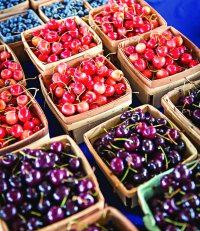 Keeping the market gritty, authentic, local and a place where everyone is part of Detroit’s renaissance are among the goals of Eastern Market Corporation (EMC), says Dan Carmody, the organization’s president. EMC, a public-private partnership, took over market management from the city in 2006 and today sponsors a multitude of initiatives to foster its vision “to shepherd Eastern Market’s rich history to nourish a healthier, wealthier and happier Detroit.”
Keeping the market gritty, authentic, local and a place where everyone is part of Detroit’s renaissance are among the goals of Eastern Market Corporation (EMC), says Dan Carmody, the organization’s president. EMC, a public-private partnership, took over market management from the city in 2006 and today sponsors a multitude of initiatives to foster its vision “to shepherd Eastern Market’s rich history to nourish a healthier, wealthier and happier Detroit.”
Projects promoting food justice and equal access to fresh food throughout the city fit the “nourish” category. For example, because many residents don’t have transportation, the market created pop-up mobile markets in 20 locations around metro Detroit. It offers nutrition education in cooperation with businesses and hospitals to teach their employees about healthy food options. Eastern Market also welcomes shoppers with SNAP and other food assistance programs, making fresh produce more available.
Partners in food justice
One man-about-the-market, chef Phil Jones, tackles a number of projects to foster food justice and healthy eating. He hosts demonstrations and teaches basic cooking skills that he says have been lost to fast-food dining and lack of access to fresh ingredients. He also manages and operates Red Truck Fresh Produce, a partnership between Eastern Market Corporation and Community Growth Partners. Red Truck sells fresh fruits and vegetables at the district’s Gratiot Central Market, a place previously known strictly as a source for all things meat. Working with Goodwill Industries, Red Truck is staffed by U.S. military veterans as part of a job-training program.
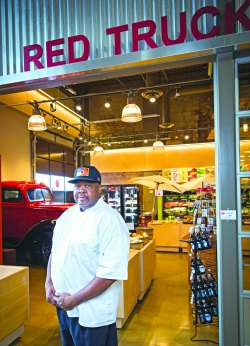 Other market programs encourage food entrepreneurs and the jobs they create. Through Detroit Kitchen Connect, for example, Eastern Market provides people striving to establish new food businesses with low-cost licensed commercial kitchen space in a newly remodeled market shed. EMC also partners with FoodLab Detroit, which helps individual food businesses start and grow.
Other market programs encourage food entrepreneurs and the jobs they create. Through Detroit Kitchen Connect, for example, Eastern Market provides people striving to establish new food businesses with low-cost licensed commercial kitchen space in a newly remodeled market shed. EMC also partners with FoodLab Detroit, which helps individual food businesses start and grow.
Much of that happens behind the scenes, unnoticed by the throngs of shoppers in the market sheds who are simply there to enjoy the festive atmosphere and take in this Midwestern bazaar of fresh food, crafts, street art and camaraderie.
“You may find yourself shopping next to a grandma with a bunch of little kids, a new resident or someone visiting from the burbs,” Liz says. “You wind up chatting about the quality of the food, where to get the best tomatoes, where to find the best price on steak.” It’s a simple interaction that creates connection, but one that’s rare in many communities. Says Liz, “What is great about Eastern Market is that it is a place where all Detroiters come and all feel welcome on any given day.”
If you go:
Here are a few tips to make your visit to Eastern Market great:
SET YOUR GPS for the market’s welcome center at 1445 Adelaide on Detroit’s east side.
FIND PRODUCE, MEAT AND BAKED GOODS at the Saturday market, which takes place year-round, 6 a.m. to 4 p.m., and at the smaller scale Tuesday market, June through October.
EASTERN MARKET’S HOLIDAY MARKETS take place in November and December. Shop to the tunes of carolers and the ho-ho-ho of Kris Kringle. You’ll find everything from Thanksgiving trimmings and pumpkins to locally grown Christmas trees and wreaths, homemade holiday treats and beverages.
EASTERN MARKET BECOMES THE LARGEST OPEN-AIR FLOWER MARKET in the U.S. on Flower Day, held annually on the Sunday after Mother’s Day.
BE SURE TO EXPLORE BEYOND THE MARKET SHEDS to discover food shops such as DeVries & Co. 1887 and Gratiot Central Market, the art gallery Wasserman Projects, the funky shop The Detroit Mercantile Company, among many others. Sample some of the city’s oldest and newest establishments including Roma Cafe and Detroit City Distillery.
JOIN FOOTBALL FANS AS THEY TAILGATE AT EASTERN MARKET before every Detroit Lions home football game, then walk to nearby Ford Field or take a shuttle. Tailgating proceeds support the market’s work to provide access to good food and grow local food businesses and jobs.
Terri Peterson Smith is a Minneapolis freelance writer who covers travel and the environment. She is the author of the book Off the Beaten Page.






